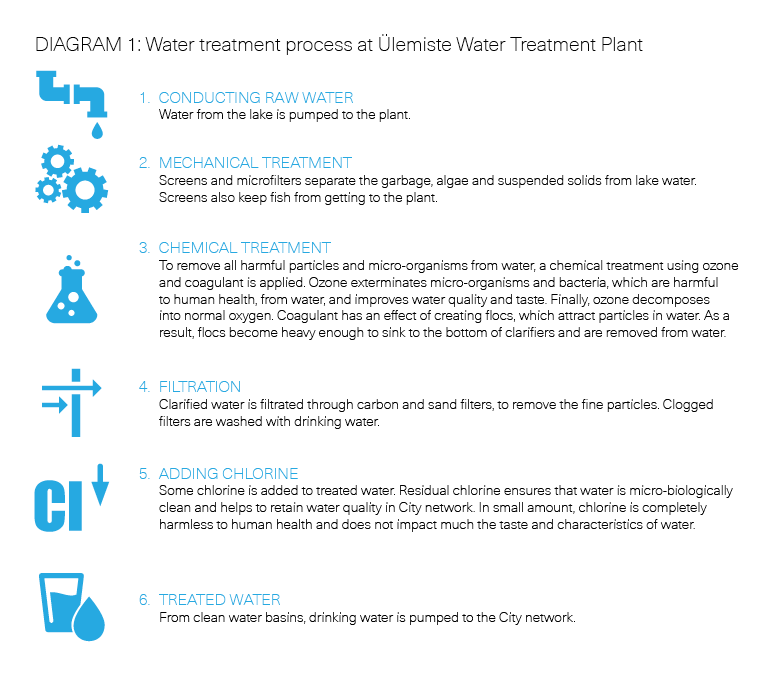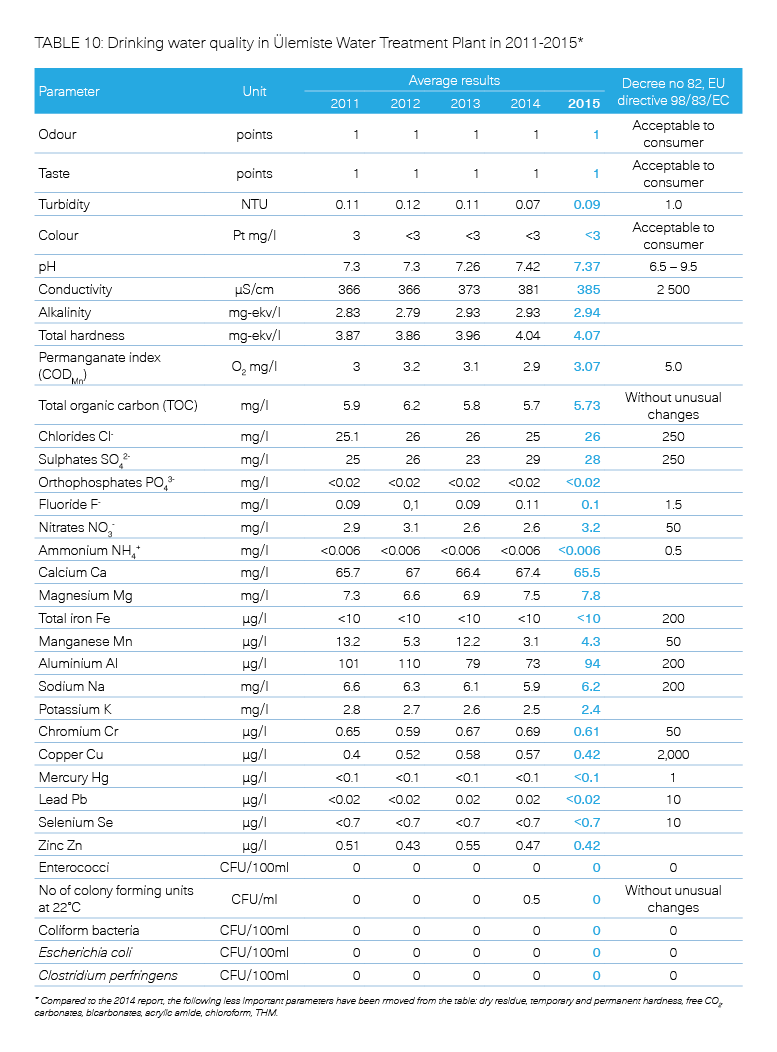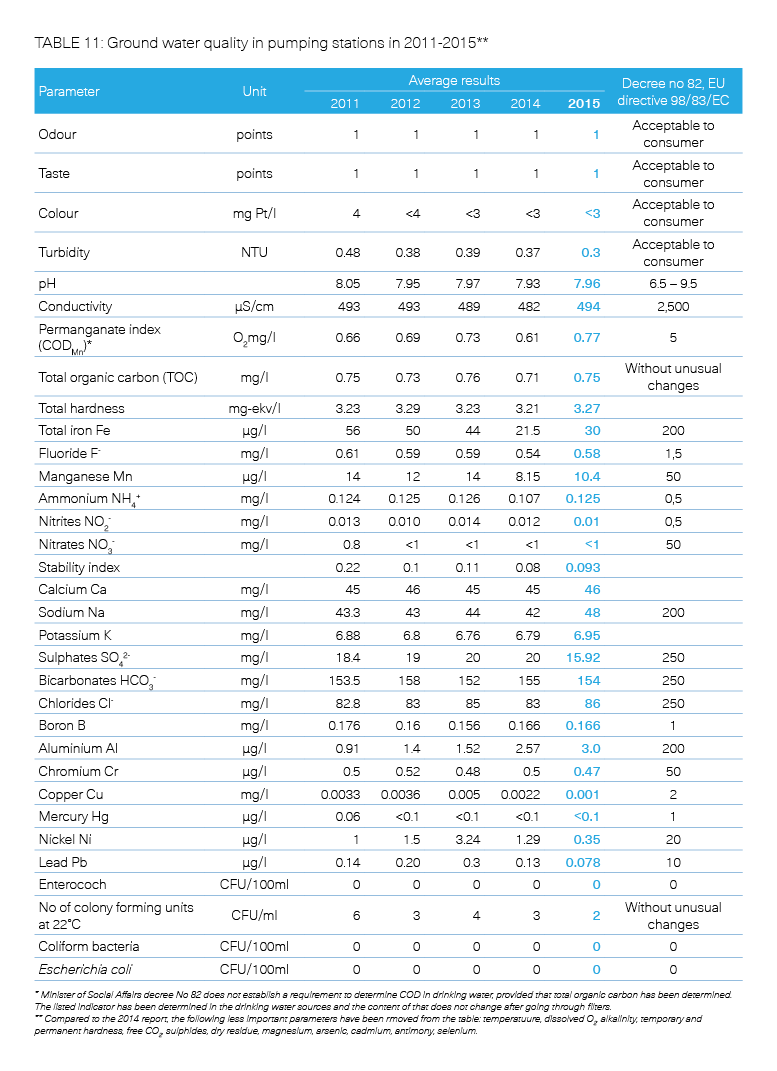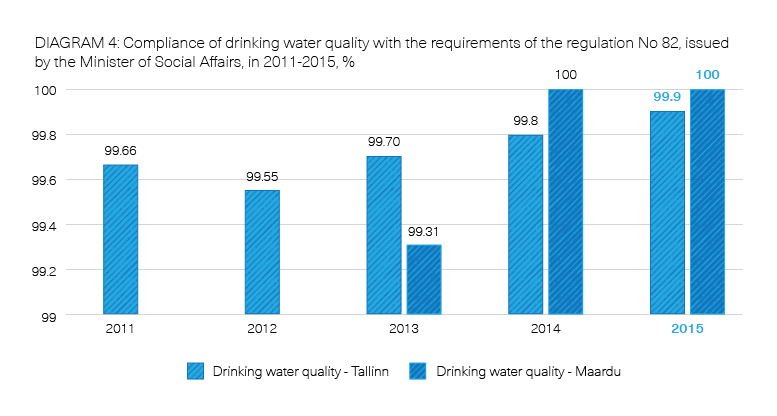Drinking Water Production and Quality
Drinking water quality is required to comply with the Regulation No 82 “Quality and Control Requirements and Analysis Methods for Drinking Water”, issued by the Minister of Social Affairs on 31 July 2001 (hereinafter referred to as the Regulation No 82), originating from the Estonian Water Act and the European Union Drinking Water Directive 98/83/EC.
The water quality is monitored following the monitoring programmes approved by the Health Board. Samples are taken from the raw water (Lake Ülemiste, the catchment area thereof, and ground water), treatment process, bore-wells, as well as the customer taps. Water analyses are carried out by the Company’s water and microbiology laboratory, which is one of the largest water laboratories in Estonia. The quality of the analyses is guaranteed by the certified samplers and laboratories accredited by the quality management system (EVS-EN ISO/EC 17025 standard), using modern equipment and employing professional staff. In 2015, our water and microbiology laboratory performed a total of 99,000 analyses.
Number of people drinking tap water has been continuously growing over the recent years. While in 2011, 48% of our customers trusted to drink tap water, in 2015 this number was already 85%. The growing trend of drinking tap water is definitely based on the excellent water quality and increased consumer awareness.
Surface water treatment process
Ülemiste Water Treatment Plant treats water extracted from the lake by applying a treatment scheme which is used world-wide. Due to the quality of surface water in Lake Ülemiste, the law stipulates that in order to achieve the required quality of the drinking water, surface water must undergo mechanical and chemical treatment – preliminary ozonation, coagulation, clarification, filtration and disinfection.
To improve the water treatment process performance, four filters were regenerated in 2015. To reduce the load of filters, a water recirculation system of clarifiers’ sludge catcher was built at the old water treatment plant, which enables additional treatment of water with high turbidity after flushing process.
Ground water treatment
Ground water used for producing drinking water usually falls under the quality class I-III. Ground water from Ordovician-Cambrian aquifer usually falls under the quality class I and does not need any treatment. However, ground water from Cambrian-Vendian aquifer, which is the main drinking water source, falls under the quality class II or III and requires treatment. The main reason is mostly the natural excess content of iron, manganese, or ammonium, resulting in higher turbidity of water than usual.
In order to supply compliant drinking water, we treat ground water by using filtration and aeration to remove excess iron, manganese and ammonium from the water. The Water Act foresees the preservation of ground water as similar to its natural conditions as possible, therefore, no chemicals are used. The samples taken after the ground water treatment process indicate a significant decrease in turbidity as well as in the content of iron, manganese and ammonium, an improvement of colour and stability index and an increase in oxygen content.
Drinking water quality in the network and at customer premises
Tap water in Tallinn and Maardu is of a very good quality and safe to drink. In terms of quality, the year 2015 did not differ from the previous periods. During the year, we took samples twice a month at the sampling points (at customer premises) agreed with the Northern Department of the Health Board.
The best ever result - 99.86% of all water samples complied with the standards - means that in 2015 we detected non-compliances only in 4 samples of the total of 2,945 samples taken from the customer taps. Non-compliances were mainly related to higher iron and turbidity parameters caused by the conditions of the water network. We immediately reacted to all non-compliances.
100% of the 144 water samples taken in Maardu in 2015 complied with the standards. Before connecting with Tallinn water network, the quality compliance of drinking water in Maardu was only 33%.
Water network maintenance and related investments
We are constantly performing maintenance and rehabilitation works on the network to retain and improve the drinking water quality. We regularly clean and flush the water network to guarantee high drinking water quality for the consumers. During the cleaning process the sediment build-up is removed from the network and this is one of the key methods in improving water quality in distribution networks. In 2015, air-scouring pipe cleaning method was carried out on 140 km of water network.
Investments in replacing old water pipes have facilitated an improvement in water quality at customer premises and a more efficient use of water resources. Each year, we renovate at least 5 km of sewerage network and 5 km of water network, in line with Services Agreement signed with the City of Tallinn.
Leakages and interruptions to water supply
One of our most important objectives is to constantly reduce water losses in the network. The level of leakages has decreased compared to the last year. The Services Agreement applied in the Tallinn service area sets us the commitment to reduce the level of leakages to 26%. In 2015, we managed to achieve 14.68%, which is an excellent performance. About ten years ago the level of leakages exceeded 32%, which means that we are currently saving over 14 thousand m3 of water a day compared to the period ten years ago. This reduction in the level of leakages has been facilitated by our consistent efforts to use the water resource sustainably and with lower losses.
Detecting and eliminating the leakages as fast as possible contributes to the reduction in the level of leakages. Our specialists have special equipment for finding leakages and, along with the zoning the network and remote reading devices, it allows us to detect the leakages faster.
In order to mitigate the inconveniences resulting from an interruption to the service, we notified the customers in advance of unplanned interruptions in 98% of the events. In case of interruptions to water supply we provide customers with a temporary water supply with the water tanks.
Water metering
The water meters we use are of high quality and comply with the European standard EN14154 and the Directive 2004/22/EC, the same as the accuracy requirements thereof. The expert studies and calibration of water meters is performed by the national Central Office of Metrology, AS Metrosert.
23,308 water meters in total have been installed to customers’ connection points, facilitating to achieve a more accurate accounting for the usage of water resources.
Pursuant to the Metrology Act, we have an obligation to verify and replace the water meters every two years. In 2015, we replaced the total of 11,561 water meters based on a programme developed for that purpose. In 2016, we shall continue our work to make sure that all our customers have duly verified water meters.





